ISSN ONLINE(2278-8875) PRINT (2320-3765)
ISSN ONLINE(2278-8875) PRINT (2320-3765)
| Alauddin Al-Omary, Wael El-Medany and Riyad Al-Hakim Associate Professor, Dept. Of CE, College of Information Technology, University of Bahrain |
| Related article at Pubmed, Scholar Google |
Visit for more related articles at International Journal of Advanced Research in Electrical, Electronics and Instrumentation Engineering
The heart Diseases cause millions of death worldwide because of the increase in the aging population and the rising of healthcare costs. There is also a demand of quality healthcare from remote locations. Technological advancements in the field of medical electronics and communication can help decreasing the cost of healthcare. In this paper a real-time heart disease monitoring system is introduced. Thesystem extracts the ECG signal from the patient, sends it through the Internet and stores it into a hospital server. The system also processes the ECG using MATLAB to alerts the doctor and hospital staff by sending email and SMS message if any abnormality is detected. The system also implements an application based on Android platform to provide online information about the patient status such as the patient's heart beat rate, ECG, patient history and provides new reading every 30 minutes.The system enables doctors to remotely follow-up the status of their patient using their computer and smart phones. The system was tested and checked by medical team for validation.
Keywords |
| Tele-health, ECG, MATLAB, Android |
INTRODUCTION |
A SYSTEM OVERVIEW |
| Heart failure and stroke cause a big burden on society due to their high costs of care, lower quality of life and premature death. It causes million of death worldwide [1]. The monitoring of patients physiological information are very important for the further treatment. Many patients can benefit from continuous monitoring as a part of a diagnostic procedure, optimal maintenance of a chronic condition or during supervised recovery from an acute event or surgical procedure. The remote monitoring also enables the patient to live his normal live and help decreasing the cost of healthcare. With the recent advance in IC design, the computing power and the memory size of mobile device have increased considerably. This development makes many mobile devices, capable of carrying out complex computing tasks and thus can be used in monitoring heart disease patient remotely |
| In this paper a real-time ECG system that facilitates the monitoring and follows up of the patient's condition is implemented. The electrocardiogram (ECG) is a test that records the electrical activity of the heart [1]. ECG translates the heart’s electrical activity into line tracings on paper. These records hold significant information that can be used to measure how fast the heart is beating and to detect the irregularity of the heartbeats. The computation power of mobile devices is utilized in this system. The proposed system has good extensibility and can easily incorporate other physiological signals to suit various tele-health scenarios. The system has two parts one carried by users, e.g. chronic patient, and the second carried by service providers e.g., the medical doctors. |
| The system starts with electronic circuit that acquires the ECG signal from the patient and sends it to a PC or laptop that serve as a home gateway. The home gateway sends the patient ECG through the internet to a hospital server. The hospital server publishes the ECG and makes it available to the hospital staffs that monitor the patient status. The monitoring can be done by the authorized person through the hospital web using PC or smart phone using Android based application. |
| The monitoring provides online information about the patient status such as the patient's heart beat rate, patient's ECG, and patient history. This information can be updated every 30 minutes.The update time can be adjusted according to doctor requirement.The system processes the ECG signal using MATLAB to detect any abnormality. The system can automaticallyalert medical service providers through Short Message Service (SMS) and Multimedia Message Service (MMS), when medical assistance is deemed crucial for the user based on the MATLAB analysis results. This is the situation when the system detects any abnormality. |
| The design of the system goes under three major stages. The first stage is the hardware implementation of the chronic patient system which includes the ECG extraction circuit and the Data logger and Acquisition System (DAQ) that sends the ECG to the home gateway. The second stage is the implementation of the medical service provider web site, abnormality detection and alert system. The detection of abnormality is done using MATLAB. The last stage is the development of Android based smart phone user interface application that enables authorized medical team to monitor the patient remotely through their smart phone. The system has been fully implemented where the ECG signals are streamedto the service provider web page as well as the medical team smart phone in real time. The results generated by the system were tested and checked by medical teams for validation. |
B RELATED WORKS |
| The use of telecommunications for remote diagnosis is growing rapidly, and there are several products and projects within mobile ECG recording using Internet solutions [2], Bluetooth technology [3], cellular phones [4], [5], WAP-based implementations [6] and wireless local area networks, WLANand Wireless Sensor Networks [7], [8], [9]. |
| A remote diagnosis system integrating digital telemetry has been developed, using a wireless patient module, a homecare station and a remote clinical station [10]. Some ECG-recording systems, like “Holter-monitoring”, are using built-in mobile telephones tosend information to the hospital [11], but are mostly used with a recording unit that physicallyhas to be carried to the hospital for analysis. In [12], [13] a wireless and wearable electrocardiogram (ECG) sensor transmitting signals to a diagnostic station at the hospital is introduced. An ECG system has been proposed based on mobile platform which transmits abnormal heartbeats identified in a patient-worn unit [14]. Another ECG analyser system has been developed to capture, record, and analyze ECG signals on a PDA device carried by the patient [15]. In [16], a Decision Support System (DSS) prototype has been provided to deliver an ECG signal to a hand-held device which will be capable of providing remote mobile communication to speed up diagnosis. |
| In the electrical and computer engineering department of Cornell University, an ECG hardware design has been implemented to measure the electrical activity of the heart [17]. Another paper presented the design, implementation, and results related to the storage system of medical information associated to the ECG signal [18]. |
C OBJECTIVES OF THE RESEARCH |
| The objective of this research is: |
| a. Design an affordable and cheap ECG system as compared with the available ECG systems. |
| b. Design afully online system that monitors the patient status in real time and sends the results to health care server. |
| c. Add features to the current available system such as: |
| i. Detecting abnormalities and send alert message immediately to doctors via e-mail and SMS |
| ii. Develop Android based application thathelps doctors to follow up their patients remotely via Web page, email, and smart phone. |
D PAPER ORGANIZATION |
| The rest of the paper is organized as follows. In section two the system architecture is given. Section 3 presents patient subsystem. In Section 4, Web Server and Database Subsystem are described. Section 5 discusses the Android unit subsystem. Section 6 shows the results and discussion. The last section is a discussion on future work and conclusion. |
SYSTEM ARCHITECTURE |
| As shown in figure (1) the system consists of the following subsystems: |
| 1. Patient unit subsystem:This includes electrodes that sense the electrical activity going through the heart, signal amplification circuit, conditioning circuit, data acquisition circuit and home gateway. The circuit takes a reading every 30 minutes and sends it to home gateway PC. |
| 2. Web Server and Database subsystem: To store the patient ECG signal data, detect any abnormality in the ECG signal and publish the results that can be accessed only by authorized people. |
| 3. Android unit subsystem: Android based application that enables doctors to access the patient details using smart phone |
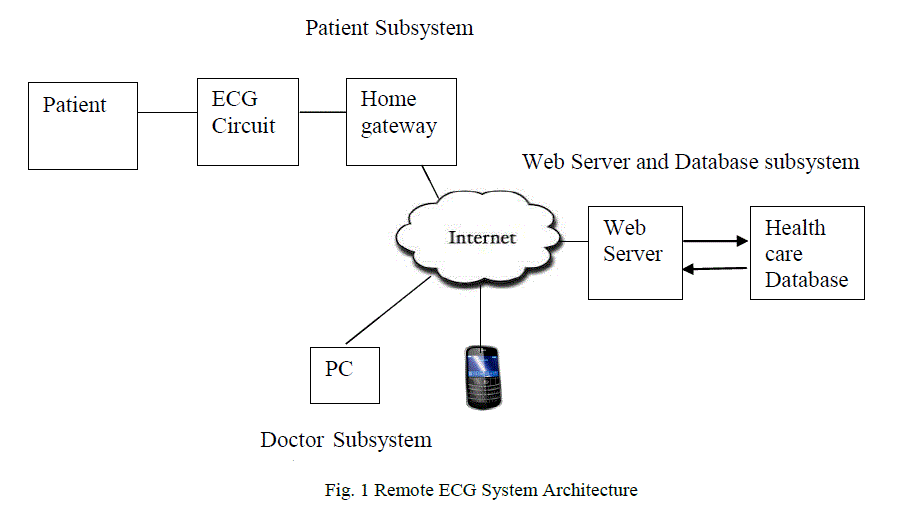 |
PATIENT UNIT SUBSYSTEM |
| The patientsubsystem shown in figure (2) contains the following components: |
| • Electrodes and cables (for the right arm, leftarm, and right leg). |
| • Right leg drive for the ground reference. |
| • Instrumentation Amplifier (IA). |
| • Signal conditioning (low pass filter, band pass filter, and notch filter). |
| • Data logger and Acquisition System (DAQ). |
| • Home gateway |
| The ECG signals have Electrode contact noise such as loose contacts, motion artifacts, and baseline drift due to respiration [19]. They also pick electro-magnetic interference caused by other electronic devices surrounding the ECG device and electrodes. Knowing that the standard ECG signal bandwidth ranges between 0.05 Hz and 100 Hz with average amplitude of 1mV only, we need to filter the signal with a Low Pass, Band Pass, and a Notch filters. Finally, the resulted signal must be amplified. Next the ECG signals need to be exported to the home gateway. In this project, USB DrDAQ data logger is acquiring the ECG data. It connects to the PC on a USB 2.0 port and to the ECG circuit's output using a probe through the scope channel of the DAQ. |
| The home gateway could be any PC, laptop, iPad, PDA or any other device that can be connected to the Internet. The Home gateway will receive the ECG signal from the data logger and sends it to the healthcare server. |
WEB SERVER AND DATABASE SUBSYSTEM |
A DATABASE IMPLEMENTATION |
| This unit provides detailed information to doctors in charge and restricted information to other authorized medical personnel or even relatives in case of elderly monitoring. It contains the patient information, ECG reading and heart beat rate. SQL Server 2008 was chosen to implement the relational database, because of its support of data mining techniques (like, Clustering, Decision tree etc.) with Online Analytical Processing (OLAP) module. Intelligent agent Query system thatreceives the abnormality analysis from MATLAB has been implemented. This agent is responsible for providing requested information to the doctor’s mobile. |
B ABNORMALITIES DETECTIONS |
| The proposed system detects the following abnormalities: |
| 1- Sinus Bradycardia in which the Heart Rate is less than 60 bpm. |
| 2- Sinus Tachycardiain whichthe Heart Rate is between (100 - 150) bpm |
| 3- Sinus Arrhythmia has Irregular Rhythm, R-R intervals must be (almost) the same. If the variation between the longest and the shortest intervals exceeds 120 ms, then an Arrhythmia is indicated. |
| 4- Arterial Tachycardiain which the Heart Rate is between (150 - 250) bpm. |
| All the diseased ECG data have been taken from PhysioNet [20]. |
| An effective algorithm has to be chosen to get indicative information from the real time monitored ECG. In such algorithms, QRS peaks should be detected accurately. There are many approaches for QRS detection including [21] non linear filtering with thresholding, artificial intelligence based method using hidden Markov models, time-recursive prediction techniques, and wavelet transforms [22]. The presence of noise in this signal is inevitable. Cubic Spline technique and digital filters have been used for base line drift removal [23]. One way of removing various noises is to use the established Pan Tompkins’ algorithm for QRS detection [24], [25]. In Pan Tompkins’ algorithm, frequency or spectrum analysis of the signal can be done using FFT algorithm. Power spectrum estimate represents the distribution of the signal power over different frequencies. From the spectrum, the frequency content of the signal can be estimated directly from the frequency sample values that correspond to the peak value. It is calculated based on the frequency representation of the discrete-time waveform [25]. |
 |
| In this paper Pan Tompkins algorithm has been applied on an ECG from a normal person and on three sets of arrhythmia data. Then the QRS detected signals are taken and power spectrum density (PSD) from each of the signals is obtained for analysis. |
| The system performs a feature matching operation for any incoming ECG recording and makes classification. If it discovers some pattern demanding urgent diagnosis, it will immediately alert the health care provider and the doctor via SMS |
| The designed ASP.NET website gives the doctors the ability to monitor their patients' condition remotely. |
| The website has three types of users: |
| • Web Admin: responsible for creating new accounts for both patients and doctors, manage their profiles, and the process of assigning doctors to patients. |
| • Doctor: Can access his/her assigned patients' ECG readings, add and view comments on his patients, add and view medical reports of his patient written by him/her or another doctor in charge of this patient. |
| • Patient: Can access his/her medical reports and view the doctor / doctors assigned to him/her. The doctor can “Filter” or search the patients either by name, File number, ID, or ID type. In order to get the full list he / she just can click the “Clear” button. The “select” column is used to access the information of a specific patient. |
ANDROID UNIT SUBSYSTEM |
| Two android applications were developed, one for the patient and another for the doctor, each having different functionality to suit the user. |
A DOCTOR APPLICATION (ECG NOTE) |
| Doctor home page contains a list of the patient’s names. The status of each patient can be seen within each patient name, to indicate whether he / she are online or not. The Green light or the Red will be shown to indicate whether the patients are in danger or not. This is useful for the emergency cases, so that the doctor can communicate directly with the patient. The doctor can access any patient info by pressing on his/her photo to see his/her details, condition and other important info such his hear beat rate. |
B PATIENT APPLICATION (MY NOTE): |
| The patient home page contains a list of icons. These icons are “Your condition”, “schedule”, “share”, and “options”. The status of the patient can be seen at the top of the page, which is displayed in a Green or Red square. |
RESULTS AND DISCUSSIONS |
| The system have been implemented, tested and achieved the design objectives mentioned in section 1.3 which are the design of affordable and cheap ECG system as compared with the available ECG systems as well as the streaming of the patient ECG to the health care provider web site so that doctors can monitors their patient status in real time. Added features like detecting the abnormalities in patient ECG and send alert message immediately to doctors via e-mail and SMS is also implemented and tested. FinallyAndroid based application that helps doctors to follow up their patients remotely via smart phone is implemented and tested. |
| Figure (3) shows the Instrumentation Amplifier, low pass filter, band pass filter and notch filter circuits. |
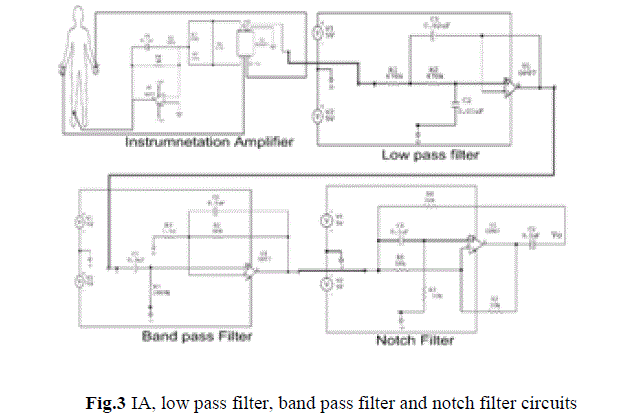 |
| Figure (4) shows patient web pages as seen by doctors. Android based smart phone doctor main page is shown in figure (5). |
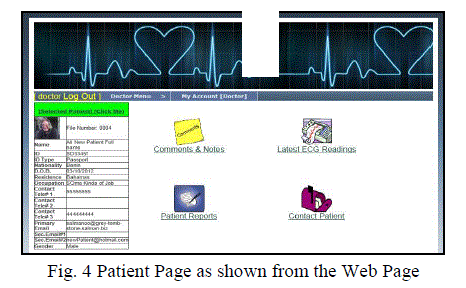 |
| When a patient is selected form this page the patient page will be shown (figure (6)). |
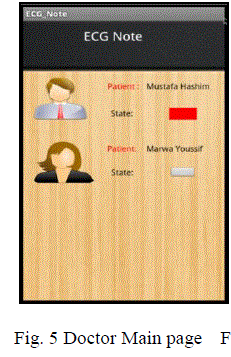 |
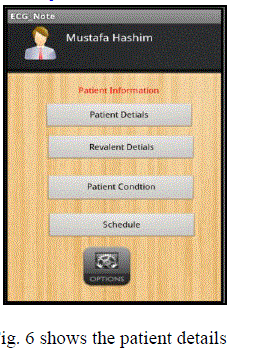 |
| When patient condition icon is selected the screen in Figure (7) will be displayed which shows the condition of the patient. The corresponding zoomed ECG of the patient is shown in figure (8). |
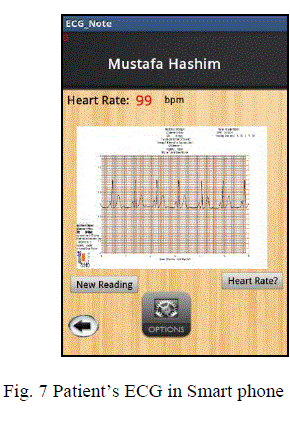 |
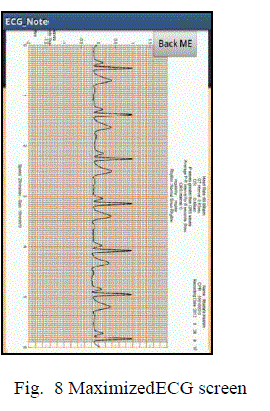 |
| The Android patient Application is shown in figure (9). The “options” icon shows a set of buttons with different options assigned to each button: |
| 1. Home button: to go directly to the home page. |
| 2. Phone button: to call the doctor. |
| 3. E-mail button: to send e-mail directly to the doctor’s e-mails address |
| 4. Message button: to send a message to the doctor’s number. |
| 5. History button: to show the patient’s medical history. |
| 6. Setting button: This is used for two purposes: |
| • To indicate whether the patient is connected to the ECG device or not. |
| • To send SMS alarm to the doctor, if it is off that means send a single SMS message and stop. Which means that the patient is not in a danger condition anymore; if it is on it means send SMS message every five minutes to the doctor. |
| 7. Exit button: to exit from the application. |
| The cost of the components from which the system was assembled is equal to USD50. The developed hardware and software took 3 months work of 4 students. |
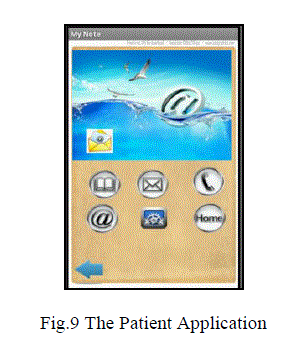 |
CONCLUSION |
| In this paper a real-time low cost heart disease monitoring system is introduced. The developed system produces a live ECG system that shows the real-time electrical activity of the heart, its rate, and analyze the readings for five of the most common and vital abnormalities, Sinus Bradycardia, Sinus Tachycardiain, Sinus Arrhythmia and Arterial Tachycardia. The system processes the ECG using MATLAB to detect these abnormalities. |
| If the system detects any of these abnormalities it will alert the doctor and hospital by sending email and SMS message. The system also implements an application based on Android platform for doctors and for patients. The doctor application provide online information about the patient status such as the patient's heart beat rate, ECG, patient history and provides new reading every 30 minutes. The system enables doctors to remotely follow-up the status of their patient using their smart phones. The system was tested and checked by medical teams for validationand the system ECG generation and abnormality detection were certified. This system provides some sort of freedom to both doctor and patient since the results are shown at real-time on a website and the doctor will be alerted on his/her Android device in case of abnormality detection. Also, it can be deployed as part of a Decision Support System (DSS) in hospitals. |
| The cost of the components from which the system was assembled is equal to USD50. As a future work, the system can be enhanced more using Programmable system on chip integrated with biomedical ECG sensor to decrease the system size and get better response time. |
References |
|